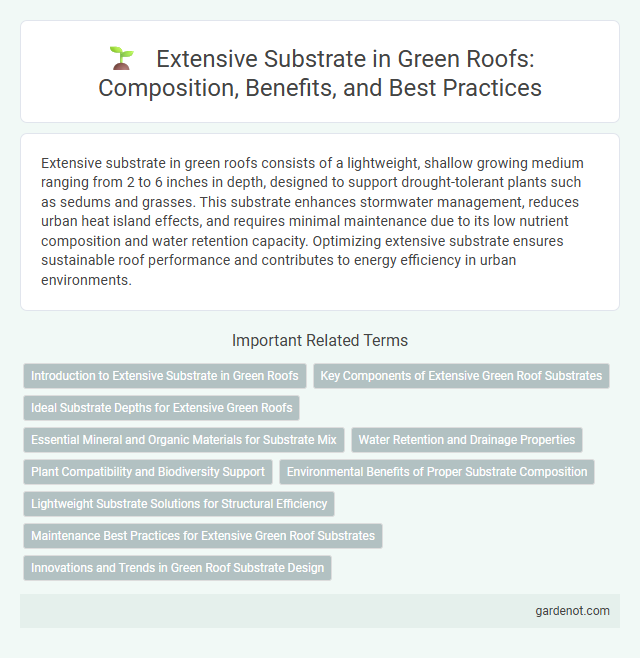Extensive substrate in green roofs consists of a lightweight, shallow growing medium ranging from 2 to 6 inches in depth, designed to support drought-tolerant plants such as sedums and grasses. This substrate enhances stormwater management, reduces urban heat island effects, and requires minimal maintenance due to its low nutrient composition and water retention capacity. Optimizing extensive substrate ensures sustainable roof performance and contributes to energy efficiency in urban environments.
Introduction to Extensive Substrate in Green Roofs
Extensive substrate in green roofs typically consists of lightweight, well-draining materials such as lightweight aggregates, organic matter, and mineral components designed to support low-maintenance vegetation. This substrate layer optimizes water retention and root aeration while minimizing structural load on the building. Its engineered composition enhances plant survival in shallow depths and harsh rooftop environments.
Key Components of Extensive Green Roof Substrates
Extensive green roof substrates primarily consist of lightweight materials such as expanded shale, clay, or slate aggregates that provide excellent drainage and aeration while supporting low-maintenance vegetation. Organic components like compost or peat moss improve moisture retention and nutrient availability, essential for the growth of drought-tolerant plants such as sedum and grasses. Properly balanced substrate particle size and mineral content prevent compaction and promote root development, ensuring long-term roof performance and plant health.
Ideal Substrate Depths for Extensive Green Roofs
Ideal substrate depths for extensive green roofs typically range from 2 to 6 inches, providing sufficient space for drought-tolerant, low-maintenance vegetation such as sedums and grasses. This shallow substrate depth optimizes lightweight load requirements while ensuring adequate water retention and root support for plant health. Proper substrate composition with lightweight materials like expanded shale or perlite further enhances drainage and aeration, critical for extensive green roof performance.
Essential Mineral and Organic Materials for Substrate Mix
Extensive green roof substrate typically consists of a lightweight blend of essential minerals such as expanded shale, pumice, or perlite, combined with organic materials like composted bark or sphagnum moss to enhance water retention and nutrient availability. Optimal substrate mixes maintain a balance between drainage, aeration, and nutrient supply to support drought-tolerant vegetation while minimizing weight and structural load on buildings. Incorporating minerals rich in calcium, magnesium, and trace elements ensures plant health and longevity, making the substrate both sustainable and functional for extensive green roofs.
Water Retention and Drainage Properties
Extensive green roof substrates are engineered to balance water retention and drainage, ensuring optimal moisture levels for drought-tolerant vegetation. These substrates typically consist of lightweight, porous materials such as expanded shale, clay, or pumice, which promote efficient water absorption while preventing waterlogging. Proper water retention supports plant health during dry periods, and effective drainage mitigates root rot and structural damage by channeling excess water away quickly.
Plant Compatibility and Biodiversity Support
Extensive substrates for green roofs typically consist of lightweight, well-draining materials like pumice, expanded clay, or organic compost, designed to support drought-tolerant, low-maintenance plants such as sedums, mosses, and native grasses. These substrates provide essential nutrients and moisture retention properties that enhance plant compatibility and promote biodiversity by creating microhabitats for various invertebrates and microorganisms. Selecting the appropriate substrate composition is critical for sustaining plant health, maximizing ecosystem services, and supporting diverse urban flora and fauna on extensive green roofs.
Environmental Benefits of Proper Substrate Composition
Proper extensive substrate composition enhances green roof performance by improving water retention, supporting drought-resistant vegetation, and promoting biodiversity. Optimized substrate layers reduce stormwater runoff and urban heat island effects, contributing to sustainable urban ecosystems. The balance of organic matter and mineral components fosters microbial activity, which is essential for nutrient cycling and overall environmental health.
Lightweight Substrate Solutions for Structural Efficiency
Extensive green roofs utilize lightweight substrate solutions engineered for optimal structural efficiency, typically consisting of mineral-based materials like expanded clay, perlite, or pumice to minimize load while supporting drought-resistant vegetation. These substrates offer high porosity and excellent drainage properties, reducing water retention and structural stress on buildings. Implementing lightweight extensive substrates contributes to energy savings by decreasing thermal load, thereby enhancing sustainable urban infrastructure.
Maintenance Best Practices for Extensive Green Roof Substrates
Extensive green roof substrates require minimal maintenance, focusing on weed control, irrigation management, and periodic nutrient supplementation to ensure optimal plant health. Regular inspection for substrate erosion and compaction is essential to maintain proper drainage and root growth. Implementing these best practices extends substrate longevity and supports sustainable green roof performance.
Innovations and Trends in Green Roof Substrate Design
Extensive substrates in green roof systems are evolving with innovations such as lightweight, nutrient-rich composites that enhance plant growth and water retention while reducing structural load. Recent trends emphasize the use of recycled materials, biochar integration, and tailored microbial inoculants to improve substrate sustainability and ecological performance. Advances in substrate engineering focus on optimizing porosity and moisture balance to support diverse plant communities in extensive green roof applications.
Extensive substrate Infographic

 gardenot.com
gardenot.com